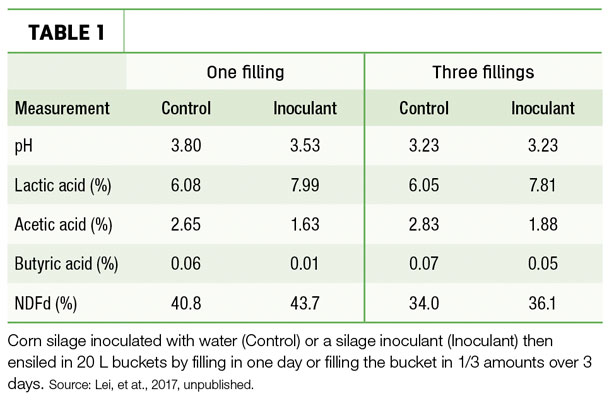When I was a young animal scientist growing up on the dairy farm, we would routinely use a silage inoculant when ensiling alfalfa haylage – but not very often for corn silage.
Even during my graduate student years, the prevailing thought process was: It was work to mess up ensiling corn silage. So the prevailing theory was: Alfalfa/grasses needed help via a silage inoculant, but corn silage did not except in extreme cases or as an insurance policy.
This perspective is still encountered today. However, early in my professional career, my perspectives and recommendations changed on using a silage inoculant for all crops for a number of practical reasons and published research.
Modern inoculants
Comparing today’s silage inoculants to products 30 to 40 years ago for efficacy is an almost unfair comparison. Those early products were basically assisting in lactic acid generation during the ensiling process to simply reduce pH by using limited bacterial numbers and strains.
Combine with lack of accurate application methods (throw or sprinkle a coffee can across the silage wagon), and it is no wonder product efficacy for the money spent was a concern.
In contrast, today’s silage inoculants have been well researched through intensive product development and testing programs in industry and academic institutions.
In the ensuing years, many improvements have been made in the area of silage inoculants, such as new and novel bacteria, using multiple bacterial strains, bacterial numbers to apply per gram of silage, fiber- and starch-degrading enzymes, yeast and mold inhibitors, antioxidants, bio- or bacteria stimulants, improved manufacturing processes, heat-sealed packaging, along with accurate application equipment adjusting application rates based on moisture content.
Inoculant recommendations
My first recommendation is for the dairy producer to use a silage inoculant when harvesting and ensiling any forage crop.
The advantages (depending on product) include but are not limited to rapid lactic acid production, rapid pH drop, dry matter retention, conservation of simple sugars and their energy, less heating by inhibiting carbohydrate oxidation, reduced protein degradation, lower soluble protein and ammonia concentrations, longer bunk stability, increased dry matter intake, improved milk production and milk composition.
My second recommendation is applying the silage inoculant as soon as possible after chopping the forage (i.e., chopper application). Certainly, applying a silage inoculant at the silo or bunker can work, but there is more risk for product failure.
As chopping releases the plant cell contents (sugars, moisture, etc.), a competition ensues between good bacteria and bad/pathogenic bacteria on the plant. By adding more good bacteria, it ensures the good bacteria can out-compete the bad bacteria, which ensures maintaining harvested forage quality. So the sooner the product is applied, the better.
One area where silage inoculants can provide an impact is nitrate detoxification for drought-stressed forages. Generally, ensiling will reduce nitrate concentrations approximately 50 percent, but the use of a good silage inoculant may achieve nitrate detoxification of 75 percent or more. If nitrate accumulation is a concern (i.e., Dakota drought area), never feed any unfermented or fermented forages without getting a nitrate test first – because livestock have been lost due to nitrate toxicity.
Inoculants and mycotoxins
An area where silage inoculants won’t have much impact is on mycotoxins. Mycotoxins are the byproducts of mold and fungus growth. If the mold is growing in the bunker, pile or silo, using a silage inoculant may inhibit mycotoxin formation, but this is a rare situation. Generally, forage mycotoxin contamination occurs in the field under the appropriate conditions (i.e., wet and cold or drought and hot).
Mycotoxins are very stable compounds that will not be metabolized or detoxified by any silage inoculant. To date, no silage inoculant exists in the market to mitigate mycotoxins, but the reader is assured many scientists are looking for a solution. For the foreseeable future, forage mycotoxin mitigation will require other mechanisms and technologies.
Research performance
In consulting with China’s Gansu Agricultural University and the Gansu Academy of Agricultural Sciences under the leadership of Jianping Wu and his team, we have conducted a very simple applied silage study demonstrating silage inoculant performance.
For example, in the U.S., dairy producers strive to continue silage harvesting until the bunker/silo is filled or the pile is completed, but weather and breakdowns can interrupt silage harvest, as well as stopping for the night.
In contrast, depending on the Chinese dairy operation, it can take one to two weeks to fill a large bunker, so our theory was: Using a silage inoculant might mitigate the effects of slow filling or stopping for the night. The study demonstrated the benefits of using a silage inoculant when completing the ensiling process in one or three days (Table 1).

However, the longer it takes to fill a silo (i.e., three fillings over three days) resulted in a decrease in neutral detergent fiber digestibility that could not be overcome by the use of a silage inoculant.
Summary
In conclusion, today’s silage inoculants are value-added solutions that generate an excellent return on investment for the dairy operation. Silage inoculants have been shown to reduce shrink loss by 3 percent or more and improve feeding value by 1 to 2 percent or more. Investing in silage inoculants will positively reduce your future cash demands by making your silage go further. These products are well researched to provide consistent performance.
A silage inoculant should be used at harvesting. The use of silage inoculants on the dairy operation is highly recommended to provide the features and benefits for harvesting and storing forages that will maintain or enhance forage quality and digestibility to meet animals’ nutrient requirements.
The selection of a silage inoculant having specific features and benefits will depend on the individual producer’s requirements for their livestock operation. There are several options on the market that will meet these requirements while providing excellent performance. Of course, these benefits will only be provided if the product is applied at the right time, at the right rate, with the appropriate applicators and the equipment operating correctly.
Given that silage inoculants can be applied in dry or liquid forms, be sure the applicator system is working appropriately for flow rates, pressures, water source, etc. For example, using chlorinated water when mixing a liquid silage inoculant is basically applying water because the chlorine kills the bacteria in the product.
To get the best silage and the greatest return on investment, be sure to use a silage inoculant and pay attention to the details. ![]()
ILLUSTRATION: Illustration by Kristen Phillips.

-
David P. Casper
- Dairy Technical Services Leader/Dairy Nutritionist
- Furst-McNess
- Email David P. Casper






